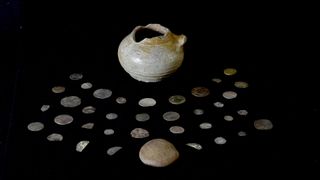330-year-old coin hoard hidden in Scottish fireplace may have been buried moments before MacDonald clan massacre
Archaeologists in Scotland have discovered a rare pot of coins in the fireplace of Alasdair "Maclain" MacDonald, the massacred chief of the MacDonald clan.

A cache of coins secreted away in a Scottish stone fireplace may have belonged to a clan chief killed in a 17th-century massacre, according to archaeologists excavating the remains of a hunting lodge in Glencoe. The diverse collection of coins was likely hidden by someone unable to return and retrieve them.
Located in the highlands of western Scotland, Glencoe is now a national scenic area due to its numerous waterfalls and trails. But it is also infamous for a brutal and bloody conflict between the MacDonald clan and government forces in 1692.
The MacDonalds of Glencoe were targeted for failing to pledge their allegiance to the monarchs William III and Mary II. More than 100 government soldiers were dispatched to round up and kill the MacDonalds, including their chief, Alasdair "Maclain" MacDonald, and ultimately several dozen clan members were massacred.
Archaeological work this summer undertaken by the University of Glasgow identified Maclain's "summerhouse," or a kind of hunting lodge and feasting hall used by the chief during his tenure from 1646 to 1692. The excavation team found pottery, glass and leatherworking materials, pins and spindle whorls — all common, everyday items. But they were surprised to discover a pot full of coins hidden in the grand fireplace.
Related: Oldest Scottish tartan ever found was preserved in a bog for over 400 years
Lucy Ankers, the University of Glasgow student who found the pot beneath a hearth stone slab, said in a statement that she "wasn't expecting such an exciting find as one of my firsts, and I don't think I will ever beat the feeling of seeing the coins peeking out of the dirt in the pot."
The 36 silver and bronze coins vary in date from the late 1500s through the 1680s. Most of them were made locally, but coins from France and the Spanish Netherlands (today, largely the area of Belgium and Luxembourg) were also present, possibly mementos of Maclain's youthful travels abroad.
"What's really exciting is that these coins are no later than the 1680s," Michael Given, a senior lecturer of archaeology and co-director of the project, said in the statement. "So were they buried in a rush as the Massacre started first thing in the morning of the 13th February 1692?"

Edward Stewart, the project's excavations director, said that their work at Maclain's summerhouse lets them better understand the importance of these lands to local clan elites in the 17th century. But it also speaks to "the everyday lives of those who lived here, worked the land and minded the cattle, allowing us to tell their stories as well as these grand tales of chiefs and their retinue," Stewart said in the statement.
While Maclain's summerhouse has been fully excavated, the team is now poring over the finds and environmental samples to learn more about this important time in Scottish history.
"These exciting finds give us a rare glimpse of a single, dramatic event," Given said. "It's a real privilege, as archaeologists, to hold in our hands these objects that were so much part of people's lives in the past."
Live Science newsletter
Stay up to date on the latest science news by signing up for our Essentials newsletter.

Kristina Killgrove is an archaeologist with specialties in ancient human skeletons and science communication. Her academic research has appeared in numerous scientific journals, while her news stories and essays have been published in venues such as Forbes, Mental Floss and Smithsonian. Kristina earned a doctorate in anthropology from the University of North Carolina at Chapel Hill and also holds bachelor's and master's degrees in classical archaeology.
Most Popular

By Ben Turner

By Ben Turner

By Robert Lea

By Sascha Pare

By Harry Baker